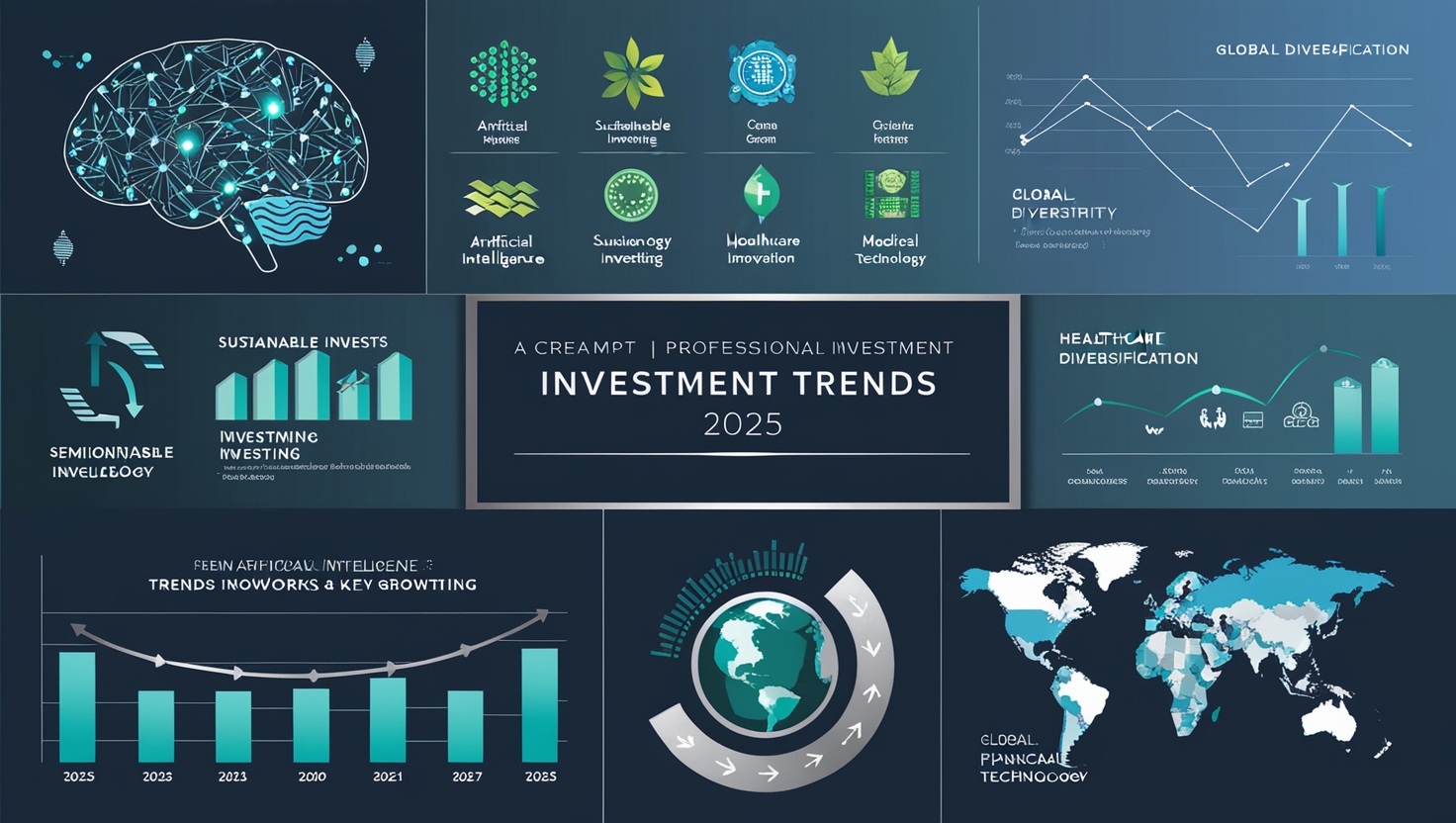Evolution of the Investment Landscape in 2025
The investment world is evolving at an unprecedented pace, with investor preferences constantly shifting and technological advances enabling investors to construct portfolios in innovative ways. Understanding current and future investment trends has become crucial for anyone seeking to achieve rewarding and secure returns simultaneously.
Studies indicate that financial markets are undergoing a fundamental transformation in 2025, driven by multiple factors including technological developments, environmental transitions, monetary policies, and geopolitical changes. These combined factors create new investment opportunities and reshape traditional sectors.
Artificial Intelligence: The Digital Investment Revolution
Growing Demand for AI Technologies
Artificial intelligence is leading a new wave of innovation in the financial sector, with search volume for "AI stock trading" growing more than 2,400% over the past 5 years. This massive growth reflects increasing confidence in technology's ability to improve investment decisions and achieve better returns.
Studies predict that the global AI market will reach $1.81 trillion by 2030, with a compound annual growth rate of 36.6%. This expected growth opens wide horizons for investment across various components of the AI ecosystem.
Next-Generation Robo Advisors
Robo advisor platforms are experiencing remarkable development, transitioning from simple automation to intelligent platforms capable of:
- Modeling potential economic shifts and predicting optimal investment strategies
- Developing new trading strategies within milliseconds
- Customizing investment portfolios based on individual user needs
- Analyzing big data for more accurate decision-making
Major banks and financial institutions are investing heavily in these technologies. For example, JPMorgan Chase is developing IndexGPT, a generative AI platform that will select investments tailored to user needs.
Investing in AI Infrastructure
The growth of the AI sector requires massive infrastructure investments, including:
- Data Centers: Experiencing increasing demand to support intelligent applications
- Semiconductors: A vital sector for running AI algorithms
- Cooling and Power Solutions: Essential for efficiently operating data centers
- Software and Applications: Developing AI application solutions
Sustainable Investing: ESG as an Essential Strategy
Growth of Environmental and Social Investments
ESG (Environmental, Social, and Governance) investments have experienced tremendous growth in recent years, with Morningstar reports indicating that nearly 70% of asset owners believe ESG factors have become more important over the past five years.
Data confirms this trend, showing:
US ESG funds reached $4.5 trillion in assets in 2021, expected to grow to $10.5 trillion by 2026
PwC predicts that ESG assets will comprise one-fifth of all assets by 2026, reflecting the fundamental shift toward sustainable investing.
Superior Performance of ESG Portfolios
Research shows that ESG portfolios have provided better returns over the past five years, with notable excess returns particularly in Europe where ESG portfolios provided a 1.59% annual excess return. Globally, ESG portfolios produced 0.13% better returns compared to benchmarks.
Growth of ESG ETFs
ESG Exchange-Traded Funds have seen remarkable growth, with:
- Search interest in "ESG ETF" growing more than 444% over the past 5 years
- ESG ETF assets surpassing $97 billion at the close of 2022
- More than 295 sustainable ETFs in the United States as of mid-2023
Energy Sector: Transition to a Sustainable Future
Increasing Energy Demand
With technology sector development, energy requirements are increasing significantly. For comparison, a single Google search takes 0.3 watt-hours of electricity, while a ChatGPT request takes 2.9 watt-hours, almost 10 times more consumption.
Global electricity demand from AI could rise by 5% by 2025, adding more than 80TWh of annual consumption.
Renewable Energy Investment
Although around 60% of electricity is currently generated using fossil fuels, the transition to sustainable energy presents tremendous investment opportunities in:
- Renewable Energy Infrastructure: Solar and wind energy projects
- Electric Vehicle Technology: Battery manufacturing and charging stations
- Energy Storage Systems: Advanced energy storage technology development
- Smart Grids: Electricity infrastructure modernization
Government initiatives for net-zero emissions and consumer demand for clean energy significantly drive sector growth.
Fixed-Income Investments: Stability and High Returns
Return of Bond Attractiveness
Thanks to high interest rates, fixed-income investments posted returns above 5% in 2023. This increase made these investments attractive again for stability-seeking investors.
High-Yield Savings Accounts
High-yield savings accounts (HYSA) are one area of interest for conservative investors:
- National average rate for savings accounts is 0.58%
- High-yield savings accounts can yield over 5%
- Ally's rate increased from 0.6% in May 2022 to 4.25% in August 2023
Money Market Funds
Money market funds experienced significant growth, with:
Assets in money market funds totaling more than $5.1 trillion in the first quarter of 2023, with expectations of more than $1.5 trillion flowing into money market funds in 2023 alone
Money market fund rates have been hovering around 5% in 2023, the highest rates in 15 years.
Healthcare Sector: Sustainable and Profitable Growth
Growth Projections in Healthcare
The healthcare sector is heading toward significant growth, with the Economist Intelligence Unit (EIU) forecasting nearly 6% increase in global healthcare spending. McKinsey projects healthcare profits to grow at a compound annual growth rate (CAGR) of 7% from 2022 to 2027, reaching an impressive $819 billion.
Key Growth Drivers
Primary factors behind this growth include:
- Improved cost efficiency in healthcare service delivery
- Higher reimbursement rates from insurance companies
- Integration of AI applications in healthcare
- Population aging and increased demand for healthcare services
AI in Healthcare
The integration of AI applications in healthcare is expected to revolutionize the industry, with potential to generate $150 billion in annual savings by 2026.
Technology Sector: Continuous Growth Engine
Tech Job Growth
Big tech will remain a major driving force, supported by continuous developments in AI, 5G, and cloud computing. US tech jobs are expected to grow significantly, from 6 million jobs in 2024 to 7.1 million by 2034, doubling the growth rate of the overall workforce.
AI Investment
AI alone represents a transformative force, with IDC Research projecting global spending on AI to more than double between 2024 and 2028, achieving a compound annual growth rate (CAGR) of 29%.
Technology Investment Areas
Promising areas for technology investment include:
- AI-enabled applications
- Infrastructure and hardware
- Semiconductors
- Storage systems and servers
- Associated services like cloud computing
Geographic Diversification: Expanding Investment Horizons
Importance of International Diversification
Global diversification doesn't just spread risk; it creates avenues for a variety of investment choices with varying degrees of risk and return. By considering international markets, investors can broaden their portfolios and access opportunities that may outperform domestic options over time.
Emerging and Developed Markets
International investments provide access to:
- Developed Markets: Stability and advanced technologies
- Emerging Markets: Rapid growth and high-return opportunities
- Specialized Markets: Niche sectors with significant growth potential
- Different Currencies: Hedging against local currency fluctuations
Private Markets: Limited Growth Opportunities
Growing Interest in Private Markets
Private markets appear poised for a rebound in 2025, driven by supportive market conditions and expectations for accommodative monetary policies. Demand for private market strategies is robust across both institutional investors and individual investors.
Promising Sectors in Private Markets
Both LPs and FAs identify technology and healthcare as the most promising sectors for private markets investments. However, investors' enthusiasm for ESG-focused opportunities appears to be waning as the topic becomes politically divisive in some markets.
Preferred Investment Strategies
Investors favor allocating capital to:
- Co-investments
- Large buyouts
- Secondary markets
- Growth investments
With continued focus on North America and Europe.
Innovative Technologies: From Virtual Reality and Beyond
Virtual Reality Platforms
Virtual reality platforms are changing how businesses engage with customers, creating exciting opportunities for investors interested in tech-driven growth. Imagine a world where virtual product demonstrations allow customers to interact with goods before buying or where immersive training environments revolutionize employee onboarding processes.
Diverse Applications of Innovative Technologies
Potential applications of virtual reality extend beyond retail and training, including:
- Real Estate: Virtual tours saving time for buyers and sellers
- Education: Interactive classrooms and educational simulations
- Medicine: Medical training and virtual surgeries
- Entertainment: Advanced games and interactive content
Investment Challenges and Risks
Macroeconomic Challenges
Investors face multiple challenges in 2025, including:
- Inflation: Impact on purchasing power and real returns
- High valuations: Risks of price corrections in some sectors
- Geopolitical tensions: Impact on global markets
- Interest rate volatility: Effects on different sectors
Risk Management
To address these challenges, experts recommend:
Broad diversification across sectors and geographic regions, regular portfolio reviews, and long-term investing rather than short-term speculation
Investment Strategies for the Future
Building a Balanced Portfolio
To build a successful investment portfolio in 2025, consider:
- Balance between growth and safety: Combining high-growth investments with stable investments
- Sector diversification: Distributing investments across multiple sectors
- Geographic diversification: Investing in different markets
- Periodic rebalancing: Regular portfolio review and adjustment
Long-term vs. Short-term Investment
Studies indicate that long-term investment in emerging trends like AI and renewable energy achieves better returns than short-term speculation, especially with current market volatilities.
Conclusion and Recommendations
The year 2025 witnesses fundamental developments in the investment world, with new and exciting investment opportunities emerging in diverse sectors. From artificial intelligence reshaping financial industries, to sustainable investments achieving rewarding returns while preserving the environment, from the growing healthcare sector to innovative technologies opening new horizons.
Success in this evolving landscape requires deep understanding of trends, intelligent portfolio diversification, and patience for long-term investing. It also requires continuous monitoring of developments and readiness to adapt to market changes.
Ultimately, successful investing in 2025 depends on combining innovation with wisdom, growth with stability, and global opportunities with local understanding. Investors who embrace these principles and stay current with emerging trends will be best positioned to achieve their financial goals in this exciting era of innovation and growth.
This article provides a comprehensive overview of investment trends for 2025, but investors should always consult qualified financial advisors before making important investment decisions.




